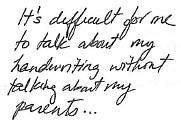
cc licensed ( BY NC SD ) flickr photo shared by i_gallagher
There is a title to a blog that I am sure is not going to impress everybody and I hope that I can elaborate on it elegantly in the following blog posts. By dead source, I do not mean that we should not have traditional books anymore. By dead source, I mean that once the words on the page are published, that is it. There is no changing no collaborating, no editing. It is the 'be all' and 'end all' of information. There is no way of changing it and no way of adding value to it.
As you are all aware from previous blog posts, I am a podcasting tragic. I love it when my lovely wife says to me 'Ashley I need you to drive down to the shops and get....' My first thought in my head is always 'Yes! More time to listen to my podcasts' It is not easy being me, but somebody has to! Anyway, one of my favourites is TWIG: This Week in Google. I always find that I am a week behind because my feed banks up and I can never keep up to date. In episode 118, Jeff Jarvis discusses his new book Private Parts and the irony of the book. The book is all about his life in public and he is sharing it in the least social means possible: traditional print media. As I was listening to it (and I encourage you to do so if you haven't already) I thought more and more about education of course and the traditional textbook.
Now the traditional textbook caters for one type of learner and is big and clunky and heavy. The traditional textbook is usually factually correct (at time of print) professional and very text heavy. Back in my day at high school, the traditional text book was like a big brick of information. It was heavy in weight and heavy going. I always remember my biology textbook. Biology was a subject that I struggled with (due to a lack of interest and maturity on my part) and the textbook used to bore me to death. There would be a ‘chunk’ of information (90% text and some pictures) and at the end some questions. Iit was used as the ‘bible’ for our subject. Everything we needed to know about biology was located in it and we used it to pass exams. If I remember correctly, I wasn’t encouraged to think and would definitely not question the knowledge being shared with me. It was a one way medium of communication. If I didn’t get it, I was up the creek without a paddle.
In TWIG, Jeff explores the notion of authors writing texts that audiences need / want. He went on to discuss the various ways we can do this and once again my mind wondered to the question: How can we make dynamic ‘textbooks’ to cater for the needs of 21st century learners? The point of this blog post is not to discuss the need or value of the textbook, but how to recreate and reshape what we already do to meet the needs of our learners. The most obvious tool that comes to mind would be the use of a wiki that can be edited by the teacher and provide dynamic content for the students undertaking the subject. I think that there has to be a balance between student created content and student delivered content. By that I mean, kids just need to be delivered content sometimes. Once the content has been delivered to them in a manner that they are comfortable with, the assessment parameters will dictate how they will demonstrate their knowledge of concepts explored. My biggest concern with the rollout of 1-1 in high schools is the delivery of curriculum. I have heard examples of textbooks and worksheets being scanned into PDF format and delivered digitally to the students. Are you serious?
I would love to hear from our leaders out there - teachers! How do you get the balance right? What mediums do you employ to deliver content to your students? Are they open places that can be shared?




